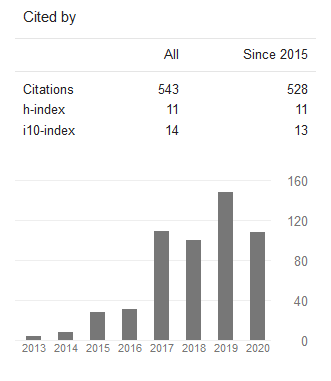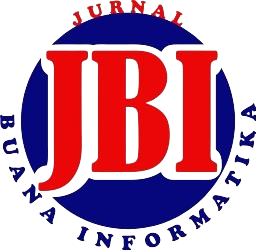Perencanaan Arsitektur SI/TI menggunakan Framework TOGAF (Studi Kasus : Dinas Perpustakaan dan Kearsipan Daerah Kota Tasikmalaya)
DOI:
https://doi.org/10.24002/jbi.v10i1.1842Abstract
Abstract.
The planning of system and information technology architecture which is abbreviated as SI/TI is one effort needed by the organization so that the applied system and information technology fits the business organization needs. The Tasikmalaya City Department of Library and Archive has not done the IS/IT architecture planning nor fully applied the IS/IT. Therefore, a system and information technology planning is required to identify the needed system and technology for the departement. The framework used in composing the IS/IT planning was TOGAF with the ADM as the architecture development method. The TOGAF's stages used in this research were started from Preliminary Phase to Phase E: Opportunities and Solutions. The result of this IS/IT architecture planning is a blueprint which is in sync with the business needs in the departement consisting of business architecture, information system architecture and technology architecture.
Keywords: ADM, Archives, Architecture, Library, TOGAF
Abstrak.
Perencanaan Arsitektur Sistem/Teknologi Informasi menggunakan Framework TOGAF. Perencanaan arsitektur sistem dan teknologi informasi atau disingkat SI/TI merupakan salah satu upaya yang diperlukan organisasi agar sistem dan teknologi informasi yang diterapkan sesuai dengan kebutuhan bisnis organisasi. Dinas Perpustakaan dan Kearsipan Daerah Kota Tasikmalaya belum melakukan perencanaan arsitektur sistem dan teknologi informasi ataupun menerapkan sistem dan teknologi informasi secara menyeluruh. Oleh karena itu, diperlukan suatu perencanaan sistem dan teknologi informasi untuk mengidentifikasi sistem dan teknologi apa yang akan digunakan. Tentu saja sistem dan teknologi informasi tersebut harus sesuai dengan struktur organisasi, tugas pokok, fungsi, serta kebutuhan di dinas tersebut. Framework yang digunakan dalam menyusun perencanaan arsitektur SI/TI tersebut adalah TOGAF dengan ADM sebagai metode pengembangan arsitekturnya. Tahapan TOGAF ADM yang dilakukan pada penelitian ini yaitu mulai dari Preliminary Phase hingga Phase E: Opportunities and Solutions. Perencanaan SI/TI menghasilkan blueprint yang selaras dengan kebutuhan bisnis di dinas tersebut yang terdiri dari arsitektur bisnis, aplikasi, data dan teknologi.
Kata Kunci: ADM, Arsip, Arsitektur, Perpustakaan, TOGAF
References
S. Kosasi, “Analisis Penerapan Enterprise Architecture dalam Investasi Pengelolaan Teknologi Informasi”, Jurnal Ilmiah SISFOTENIKA, vol. 3, no. 1, pp. 1-10, 2013.
The Open Group, “Introduction (Part I)” dalam TOGAF Version 9.1, San Fransisco, California, 2011, bab 1, bagian Executive Overview, pp. 3-8.
O. N. Putra, “Perencanaan Arsitektur Sistem Informasi Rekam Medis dan Monitoring Gizi Buruk Berbasis Cloud Computing (Studi Kasus: Dinas Kesehatan Propinsi Jawa Barat)”, Jurnal Buana Informatika (JBI), vol. 8, no. 3, pp. 161-170, 2017.
The Open Group, “Introduction (Part II)” dalam TOGAF Version 9.1, San Fransisco, California, 2011, bab 5, bagian Adapting The ADM, pp. 43-56.
H. Kusbandono, “Pemodelan Arsitektur Enterprise Menggunakan TOGAF ADM untuk Mendukung Sistem Informasi Proses Akademik pada Universitas Muhammadiyah Ponorogo”, Multitek Indonesia, vol. 8, no.1, pp. 16-35, 2014.
G. A. Suryonugroho, E. Dwiyanto, dan G. A. Ary W, “Perencanaan Strategis Sistem Informasi Dinas Kesehatan Kota Bandung menggunakan The Open Group Architecture Framework (TOGAF) dan Architecture Development Method (ADM)”, e-Proceeding of Engineering, vol. 2, no. 2, 2015.
Husain, P. N. Andono dan M. A. Soeleman, “Perspektif Baru Enterprise Architecture Pemerintahan Kota Mataram Berbasis TOGAF ADM”, Jurnal Matrik ,vol. 16, no. 2, 2017.
K. Haryono, ”Model Arsitektur Sistem dan Teknologi Informasi pada Organisasi Sektor Publik”, TEKNOMATIKA, vol. 7, no. 2, 2015.
C. M. Firmansyah dan Y. Bandung, “Designing an Enterprise Architecture Government Organization Based on TOGAF ADM and SONA”, International Conference on Information Technology Systems and Innovation (ICITSI), IEEE, 2016.
The Open Group, “Preliminary Phase” dalam TOGAF Version 9.1, San Fransisco, California, 2011, bab 6, bagian Steps, pp. 57-58.
C. Vangoslava, Zulfiandri, and M. N. Gunawan, “Perencanaan Arsitektur Enterprise Dengan Metode Togaf Versi 9 (Studi Kasus: Rumah Sakit Umum Kota Tangerang Selatan)”, Jurnal Sistem Informasi, vol. 10, no. 1, pp.1-10, 2017.
The Open Group, “Phase A : Architecture Vision” dalam TOGAF Version 9.1, San Fransisco, California, 2011, bab 7, bagian Steps, pp. 69-77.
R. Anggrainingsih, “Penyusunan Arsitektur Visi dan Arsitektur Bisnis sebagai Tahapan Perancangan Arsitektur Enterprise Universitas Sebelas Maret (USM) dengan Framework TOGAF”, Jurnal IT Smart, vol. 2, no. 2, pp. 13-20, 2013.
The Open Group, “Phase B : Business Architecture” dalam TOGAF Version 9.1, San Fransisco, California, 2011, bab 8, bagian Steps, pp. 79-91.
The Open Group, “Phase C : Information Systems Architectures-Application Architecture” dalam TOGAF Version 9.1, San Fransisco, California, 2011, bab 11, bagian Steps, pp. 109-117.
The Open Group, “Phase C : Information Systems Architectures-Data Architecture” dalam TOGAF Version 9.1, San Fransisco, California, 2011, bab 10, bagian Steps, pp. 97-108.
L. Sofyana, “Perencanaan Arsitektur Enterprise dengan Kerangka Kerja TOGAF”, Jurnal Prozima, vol. 1, no.2, pp. 64-70, 2017.
M. Y. Sanny, D. A. W. Sya’roni, and T. Suryana, “Enterprise Architecture Planning Sistem Informasi Puskesmas Pasirkaliki”, Majalah Ilmiah UNIKOM, vol. 10, no. 1, pp. 77-92, 2017.
Downloads
Published
Issue
Section
License
Copyright of this journal is assigned to Jurnal Buana Informatika as the journal publisher by the knowledge of author, whilst the moral right of the publication belongs to author. Every printed and electronic publications are open access for educational purposes, research, and library. The editorial board is not responsible for copyright violation to the other than them aims mentioned before. The reproduction of any part of this journal (printed or online) will be allowed only with a written permission from Jurnal Buana Informatika.
This work is licensed under a Creative Commons Attribution-ShareAlike 4.0 International License.










